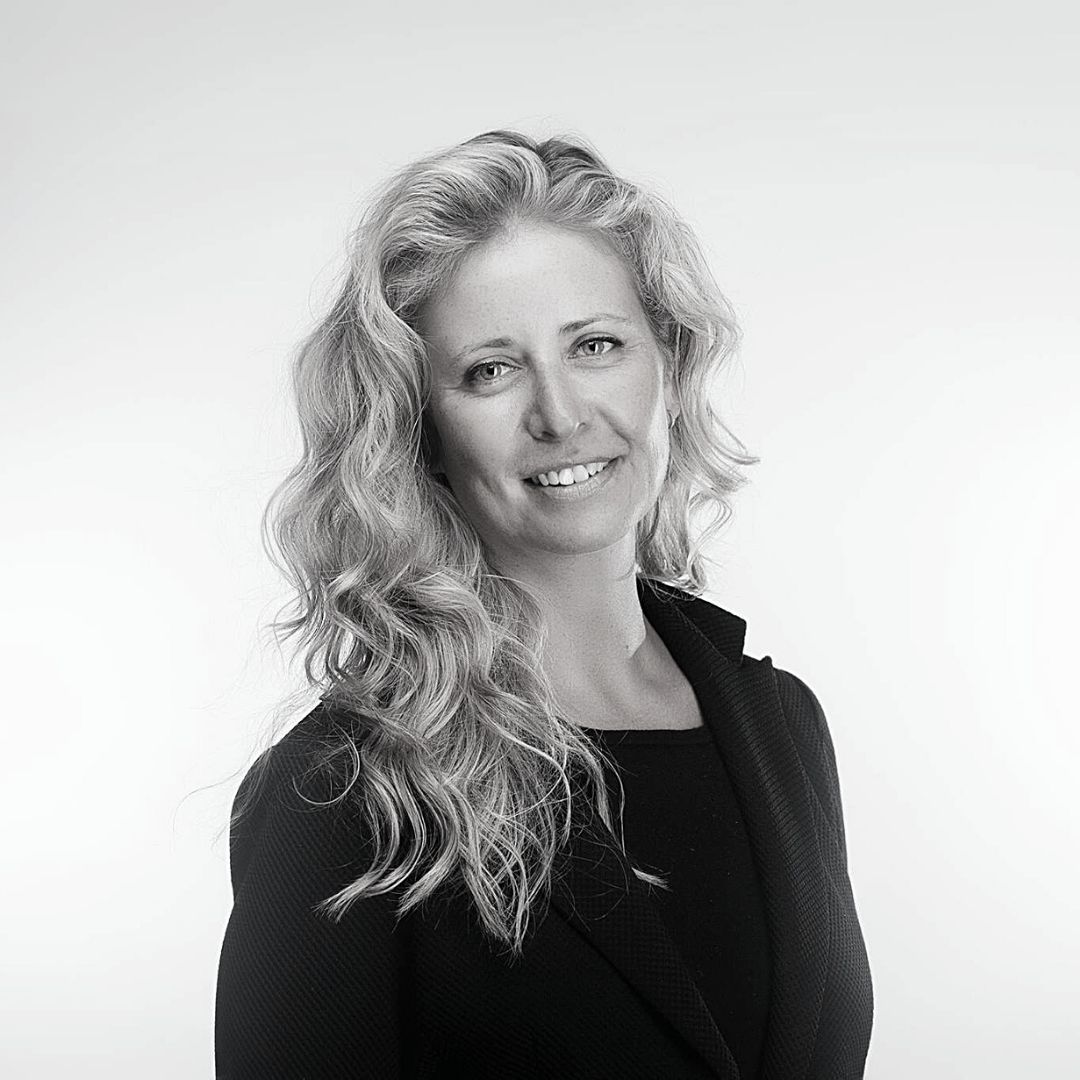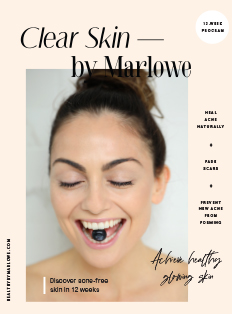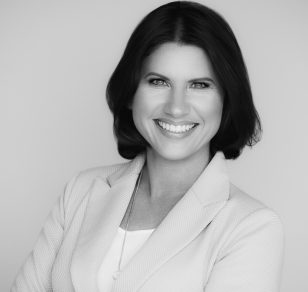
Clearing Acne From The Inside Out
Clearing Acne From The Inside Out
This week, Naturopath Dr. Julie Greenberg explains why healing acne starts within. We discuss how gut health and internal imbalance drive acne and why repairing the gut and developing a healthier diet and lifestyle are key to clearing the skin, for good.

Dr. Julie Greenberg
Founder Of Center For Integrative Dermatology
Dr. Julie Greenberg is a licensed naturopathic doctor who specializes in integrative dermatology. She is the founder of the Center for Integrative Dermatology, a holistic clinic that approaches skin problems by finding and treating the root cause. Dr. Greenberg holds degrees from Northwestern University, Stanford University, and is the Program Chair for the Naturopathic & Integrative Dermatology Series on LearnSkin.com, a program for doctors that discusses evidence-based alternative approaches to treating dermatological conditions.
Transcript
Maria Marlowe: [00:00:34] Welcome back to the Happier and Healthier podcast. Today we’re talking all things acne and gut health with Dr. Julie Greenberg. I am so thrilled to have found Dr. Greenberg because I’ve been looking for a holistic dermatologist to bring onto the show for quite some time. And to be honest with you, I found quite a few MDs and dermatologists who call themselves holistic dermatologists. But in actually talking to them, they were not so holistic. While they might recognize the role of dairy or sugar in acne, that’s about as far as it went. And they still relied primarily on pharmaceuticals in order to address acne.
Maria Marlowe: [00:01:16] Now, if you’ve been listening to this podcast for a while, you know, I’m all about finding the root cause. And that’s exactly what Dr. Julie Greenberg is about as well. She is a licensed naturopathic doctor who specializes in integrative dermatology. She’s the founder of the Center for Integrative Dermatology, a holistic clinic that approaches skin problems by finding and treating the root cause. She holds degrees from Northwestern University, Stanford University, and Bastyr University. She’s incredibly knowledgeable on this topic. And I know you guys will love it.
Maria Marlowe: [00:01:52] This episode is brought to you by the Clear Skin Plan, my 90-day program and meal plan to clear your skin from within, naturally. If you’ve suffered with acne for months, years, or even decades, it’s time to look within. Chronic acne is seldom a topical problem, but rather a sign of an internal imbalance and inflammation. Discover your root causes and remedy them with simple dietary and lifestyle changes. Head to mariamarlowe.com/clear-skin-plan to start today.
Maria Marlowe: [00:02:30] Dr. Greenberg, thanks for coming on the show.
Dr. Julie Greenberg: [00:02:33] Thanks so much for having me. I’m excited to be here
Maria Marlowe: [00:02:36] I’m excited to talk to you because you are an expert in an area that really fascinates me, which is the connection between skin and dermatology and also what we’re eating. Right? Because as a more holistic dermatologist, you’re not just looking at what’s on the outside. You’re also looking at what’s going on, on the inside. So before we jump into talking about acne and other skin conditions, I’m curious, how did you get here? How did you become a holistic dermatologist?
Dr. Julie Greenberg: [00:03:09] So technically, I think when people hear dermatologists, they’re thinking of an MD medical doctor who’s been through specific training. So I don’t actually call myself a dermatologist. I say I’m a naturopathic doctor who specializes in dermatology. So if your listeners have never heard of a naturopathic doctor, we are licensed doctors and physicians in the US and Canada. We have four years of medical school. But what are the main differences is that I think we know from our Western conventional medicine, MDs are trained in the use of pharmaceuticals. So you expect to get a prescription from your doctor when you go. And a lot of times those prescriptions are not addressing what we call the root cause. They’re addressing symptoms.
Dr. Julie Greenberg: [00:03:49] So if you have acne, you’re going to get usually antibiotics or Accutane. And I always say to patients, is the problem that you are deficient in antibiotics? Is the problem that you are deficient in Accutane? You know, obviously not. And as soon as you stop those things, the acne comes back a lot of times. So as a naturopathic doctor, I’m really trying to get to the root cause. And we say in order to get to the root cause, you have to treat the whole person. And so that’s why I say I’m a naturopathic doctor who specializes in dermatology, because I do specialize in derm, but I also specialize in the gut in order to treat that derm.
Dr. Julie Greenberg: [00:04:24] And how I came to focus on dermatology is kind of very naturopathic. And again, a whole person. I actually got there through my thyroid. In my late twenties, I was diagnosed with Hashimoto’s thyroiditis, which many women who are listening will know and have. It’s a form of hypothyroidism. That’s an autoimmune disease where we attack our own thyroid and it stops producing enough thyroid hormone. And it was really the first time I had ever dealt with a medical, a real big medical issue.
Dr. Julie Greenberg: [00:04:55] And I remember going here in Los Angeles to USC, the head of endocrinology is who I saw and I was really shell shocked at the end of the visit because he was like, OK, the reason you’re gaining weight and are tired and have hair growth on your face, you have this thing called Hashimoto’s and you’re attacking your thyroid. We don’t really know why it happens. There’s nothing we can do. Here, take this thyroid hormone. Basically, you’re going to be overweight and tired for the rest of your life. And I just walked out completely shell shocked. This was before I was a doctor. I was like, what just happened? I’m in my twenties. How is this my destiny?
Dr. Julie Greenberg: [00:05:33] And I started researching health and nutrition and I learned just how crazy what we were eating was. You know that wheat and gluten and dairy and sugar should not be the foundation of a beneficial, and healthy diet. But it also led me to our topicals because of so many of the products that we put on our skin, particularly as women. With all the products that we use, we use over a hundred and twenty-five chemicals on our skin a day. And a lot of them are endocrine disruptors. So that was the first time I really thought about skin and what I was putting on it. And it led me down this whole road. And I started researching topical skincare and making my own stuff for myself and friends and family. And it started working for me and friends and family on some of their skin diseases. And at that point I thought, this is my calling and I’m going to go back and become a naturopathic doctor and specialize in dermatology.
Dr. Julie Greenberg: [00:06:28] So it was a really naturopathic way to get to derm through the thyroid. But as we say, all of our systems are connected. We can’t chop them up like they’re separate pieces. We don’t take off our skin at night and hang it in the closet. It’s connected. It’s our largest organ. It’s connected to our blood supply and therefore to every other organ in our mental state and everything. So that’s the long story of how I got to derm.
Maria Marlowe: [00:06:52] That’s amazing. And I love how you went back to school in what, your late twenties, early thirties. You were in school?
Dr. Julie Greenberg: [00:06:59] Yeah, I went back actually in my forties, and so it was considered late to the game.
Maria Marlowe: [00:07:07] That’s amazing. And I think that’s such an inspiration to anyone listening who is feeling maybe they’re not into their career anymore. Maybe they, like you, have discovered something amazing, like nutrition and wellness, and think that they can’t do it because they’re over a certain age. But that’s definitely not the case. So that’s very inspirational.
Dr. Julie Greenberg: [00:07:26] It’s not. And I come from a business world. I have my MBA from Stanford and I thought, oh you know all that MBA is going to be worthless and really all of your training, no matter what it is, will come together for your passion. I’m now going to be on the board of a major pharmacy chain in the US and help advise them on their holistic medicine kind of path and protocol to help people get off of some of the pharmaceuticals and learn more traditional and alternative ways. So I say if you have a passion for health and wellness and you’re thinking, oh but I have all this schooling and it’s going to be a waste. It’s not. Whatever you have, you can bring that to your new practice and help people. You really can.
Maria Marlowe: [00:08:09] Yeah. And I think we each have our own unique path and all of those things that we have done before really help, really shape what we do and make us a little bit more different and unique, and can only benefit us.
Dr. Julie Greenberg: [00:08:20] Absolutely.
Maria Marlowe: [00:08:21] So, alright, let’s talk about acne. So we already mentioned a little bit about the gut and why that’s important. So let’s start with, when someone comes to you with acne, what things are you thinking? What questions are you asking them? What do you know? Because they’re presenting with acne, what are you thinking, okay, this is what’s going on below the surface?
Dr. Julie Greenberg: [00:08:43] So and you’re very right to stay below the surface because I think a lot of us, when we see dermatology, we’re like, oh, it’s on the skin. That’s an on-top-of-the-surface thing. But you’re right, it’s below the surface. It’s being driven from the inside out and you have to treat it as such. So when I’m looking at somebody with acne, I’m actually looking at somebody with a gut problem. And there’s something called the Institute of Functional Medicine, which is a big organization that trains functional medicine doctors. The big annual conference this year is in June. I will be presenting my research on acne patients and what is happening in their gut at that conference because on every patient, I run a stool test and a urine test because I am trying to specifically assess what’s happening in their microbiome. How many good bacteria and fungal elements, how many bad ones? What do I need to go in and fix?
Dr. Julie Greenberg: [00:09:35] Because even if they say… You know I’ve had patients who are really healthy individuals in their twenties, professional soccer players, eat great, obviously, exercise a lot, poop every day, have no complaints whatsoever about their GI system. I still know that there are things going on in there and I have kind of top three candidates of what’s going on. So the first thing I’m thinking is what is going on in that gut and how am I going to fix it? And the second thing is always what are they eating? Because the Western diet does play a significant role in driving acne.
Dr. Julie Greenberg: [00:10:10] I think what’s really fascinating and what blew my mind is as I started to research acne, on the one hand, we see that the rates of acne are just going up every year in Western society. And so I’ll age myself, but I’m forty-nine. I’m about to turn 50 and in my generation, it was really a teenage thing. It really was. I mean it was pretty rare for adults to have acne and it was like, oh, you’ll grow out of it once you’re done being a teen. And that was predominantly true. That is no longer the case. 90 percent of our teens in the US get acne and a significant number of adults either never get rid of their acne or have adult-onset acne. And it’s not just women. Sixty-five percent of menstruating women report acne in the week or two leading up to menstruation. But men and women in their twenties, thirties, and forties, up to 50 percent of them have acne, and women up to twenty-five percent still have acne into their forties.
Dr. Julie Greenberg: [00:11:09] So we hear these numbers and it’s like, oh okay, well, I guess everybody has acne. So maybe it’s normal. But I always say there’s a big difference between what’s common and what’s normal. And if you have acne, it’s not normal. You have a problem in your gut. Things are going wrong. And when we look at research from around the world, we’ve studied indigenous cultures. So this is like when you turn on National Geographic and you see very traditional tribes living in the forest, hunting, totally non-westernized, how we used to live, how all humans lived hundreds or thousands of years ago. We study these populations and we cannot find acne in any of them. We’ve studied tribes in Paraguay, in the Amazon jungle, in Okinawa prior to World War two, in Papua New Guinea, which is in the South Pacific.
Dr. Julie Greenberg: [00:11:59] Literally, there are tribes of twelve hundred people. They study them for weeks and years. They cannot find a single zit. And these types of tribes, don’t actually have a word for acne because they’ve never seen it. They don’t know what it is. And yet when these people move into westernized society in cities, they can and do develop acne. So there’s nothing genetically blessed about the populations that we’ve studied around the world. It really is a function of Western society and we have to come back to food. What are we eating and also what are we not eating? There’s a real lack of fiber in our diets and that completely changes our gut microbiome and sets off this issue where the bugs that are in our gut are not right. And that affects all aspects of health. Definitely acne.
Maria Marlowe: [00:12:47] So there are so many questions I want to ask off of that. But first, so you mentioned that you’ll specifically test their stool and their urine to try and figure out exactly what’s going on. And I’m assuming once you figure that out, then what are the next steps? Are you helping or providing them, I guess, with a more targeted probiotic? Or maybe, I guess if there’s a parasite or there’s something in there that needs to be cleansed. So once you get your results back, what kind of things do you usually see? What are the usual problems? And then how do you… What’s the next step? How do you fix that?
Dr. Julie Greenberg: [00:13:21] That’s a great question. So as a naturopathic doctor, I’m a trained herbalist. We are the herbalists of Western society. So I always say, if you think of India, an ayurvedic doctor. In China, there’s TCM or traditional Chinese medicine. And in Europe and America, there are naturopathic doctors and all of us are trained in the use of herbals. We have to get passports-herbs to get our licensure. So we really are herbalists. I’m also a registered herbalist through the American Herbal Guild. So I rely a lot on herbs and supplements. I do. I can prescribe pharmaceuticals. I’m licensed in Oregon, Washington, and California, but I really rarely do. So herbs and supplements and lifestyle changes like dietary changes are my main workhorses.
Dr. Julie Greenberg: [00:14:08] Once I do those tests, and this is research I’ll be presenting at the Institute for Functional Medicine, my three top conditions that I see in acne. And the interesting thing is it really does vary by the type of dermatological conditions. So this is not true for my eczema or rosacea or other patients. This is really unique to my acne patients. I see a very large percentage of Candida overgrowth. Candida is a fungal element. It’s a yeast, which is a single-celled fungal organism. We have Candida in our system. That’s not surprising, but when Candida overgrows, it really wreaks havoc. And if you’re a woman who has ever had a vaginal yeast infection, you can have a sense of that because it’s okay to have a little Candida in our vaginal flora. We aren’t going to feel that. But if you have a vaginal yeast infection, you know about it. It is terribly itchy, it’s uncomfortable, it’s red, it’s angry and irritated. And you can often have this white cottage cheese discharge, which is the Candida yeast.
Dr. Julie Greenberg: [00:15:05] So we are very in tune with it when there’s Candida overgrowth in the vagina. We don’t know in the same way when that’s happening in the gut, but it’s the same inflammation and firing up of the immune system. So Candida overgrowth is the number one thing. The second thing is H. pylori is in there. Helicobacter pylori or H. pylori is a bacteria that lives in our stomach. We used to think nothing could live in our stomach. It was too acidic because the whole point of having an acidic stomach is we want to kill off bacteria and fungal elements that we swallow either in our saliva or through food. It’s pretty dangerous, actually. Every time we eat, we’re bringing things right down into the center of our body and we don’t want to bring pathogens or bad guys in. So that stomach acid kills off all those live organisms.
Dr. Julie Greenberg: [00:15:53] Well, H. pylori get in there and somehow it’s found a way to survive, but it doesn’t like that acidity. And so it does two things. It tells the stomach, stop producing so much acid because this is pretty uncomfortable for me. And also, let’s not make it this acidic. So it does something called changing the pH and instead of it being really nice and acidic, it will become more neutral or alkaline. The pH goes up. So now we’re not killing off all the organisms and we’re not fully digesting our food, which can lead to food sensitivities. So H. pylori is that second finding and the third finding is protozoa.
Dr. Julie Greenberg: [00:16:32] Protozoa of many kinds can be anything from giardia to Blastocystis hominis to Dientamoeba. I mean, there are lots of different types of protozoa and about half of my acne patients have some form of protozoa. It’s more in the 90, 90 plus percent that have Candida and H. pylori. So really a lot of them. And I think the reason why half of them end up with protozoal overgrowth is because of this function that we talked about with H. pylori changing the stomach acid. We’re going to be exposed to protozoa through water and food. It’s not abnormal. It’s not shocking. Like, oh, no, there’s a protozoa in here.
Dr. Julie Greenberg: [00:17:07] But normally they’re supposed to hit our stomach acid and die a fiery death in that acidic cauldron. But when we have H pylori and the stomach acid isn’t so acidic some of them are like, I made it. I made it alive through the stomach. And then I tell my patients they set up a protozoa party in your gut, basically, because they made it through and they’re celebrating and now they can live and it’s harder for the immune system to kill them off once they’ve made it through that stomach. So those are my top three things that I see.
Dr. Julie Greenberg: [00:17:35] But there are always other things going on as well. So I really do like to do the testing. Naturopathic medicine is individualized medicine. And so people ask me, what’s your acne protocol? And I have to say, honestly, I don’t have an acne protocol because I have to see what’s happening and then treat that. And I have herbs and protocols that address each of the things that I see. So set of herbs for H. pylori, a set of herbs for Candida, a set of herbs for protozoal overgrowth. And there are usually other things going on as well, other bacterial overgrowths that we’re seeing, a lack of beneficial gut bacteria. And most of them have a leaky gut. So we need to work on that.
Dr. Julie Greenberg: [00:18:16] So it really does require going in and testing the individualized person. But I do have a sense of what I’m expecting to see on certain levels, and then I need to see the specifics for that person in front of me. And then we can do really targeted plans to fix those issues. And then it’s amazing what the skin will do once that gut is in a good state.
Maria Marlowe: [00:18:37] And I’m curious, how long does it usually take once you’ve discovered, okay, this is the issue here is your remedy. How long does it usually take for them to clear up their skin?
Dr. Julie Greenberg: [00:18:48] So it really varies, and I wish I knew exactly why. At the first visit, that’s when we order and run the labs. So I put people on a protocol, what I say is kind of a broad presumptive protocol. So it’s like I don’t know exactly what’s going on for you, but I have a sense. So we’re going to do these kinds of broad-spectrum antimicrobial herbs that can address a lot of things. Some said, and usually, that first follow-up visit at six weeks later, while we’re waiting for the lab results to come back, sometimes and within that first six weeks, there can be a dramatic improvement already. Other ones, there’s just so much going on, it can take two or three rounds. And after that first follow-up. Usually, follow-ups are about every two months because I like to give herbs time to work for that protocol.
Dr. Julie Greenberg: [00:19:36] And we can’t treat everything at one time. If you have H. pylori, Candida overgrowth, protozoal overgrowth, bacterial overgrowth, a lack of good bacteria, on and on and on. I can’t do all that in one protocol. So they’re kind of moving, protocols change every one to two months, depending on when we’re meeting. Sometimes it’s not until the third protocol that they come back and it’s like magic has happened and all of that foundational work was done and now suddenly things are getting better. And sometimes it’s just improvement, a little bit of improvement from protocol to protocol. And then by the X number of protocol we’re there. It’s really hard to predict. And so I always tell patients, I can’t tell you when this is going to happen, but if we stick with it, it happens.
Maria Marlowe: [00:20:19] And I think, so like you mentioned there are probably some overarching guidelines or things that will be beneficial to everyone and may make a little bit of a dent. Right? Like probably getting rid of dairy and sugar, et cetera. But then to really get that full clearance, a hundred percent, that’s when you have to really know exactly what you’re treating and what you need to fix in order to get that full remission of the acne.
Dr. Julie Greenberg: [00:20:44] Yeah, and the food is really important because while the food… So I will say I have patients who are vegan and eat amazing and lots of fiber and they still have acne. And then it’s really just a function of going and fixing what we call that gut dysbiosis. This means that there are problems in that gut microbiome. But most of my patients are eating what we call a standard American diet. The acronym is SAD because our standard American diet is sad. It is high in meat, wheat, sugar, and dairy. And when we look at things that drive acne forward, one of the causes of acne is the overproduction of sebum. Sebum is an oil gland in the hair follicle and that’s where acne occurs, in the hair follicle. It starts with that overproduction of sebum.
Dr. Julie Greenberg: [00:21:34] Well, all of those things that we really love to eat in our Western diet, they push on a pathway called the mTOR pathway, and that stands for mammalian target of rapamycin, which is a long name. But basically what the mTor pathway is it’s a growth pathway. And so there’s a yin and yang in the body. Right? We need growth, but then we also need not too much growth because too much growth is cancer. So there’s always a balancing act going on in the body. Well, mTOR gets really fired up by those foods that we eat, milk, wheat, dairy, and sugar. So the more we eat those things, the more mTOR pushes on that sebum production and is like, oh, I guess what we’re doing is we’re going. We’re going. Let’s produce more sebum. Let’s get that cranking out. And so that in that way, the diet really contributes to pushing on sebum production and causing acne to be even worse.
Dr. Julie Greenberg: [00:22:28] My patients get really sad about dairy and there’s a lot of negotiation. Well, what about sheep’s milk or goat’s milk and you know, horse milk. They get pretty desperate. And what we talk about is, I pose the question to them, what is dairy? Why does dairy exist on the planet? And they think about it. And I have a PowerPoint presentation and they’re looking at pictures of baby mammals suckling from their mom. And then they’re like, oh yeah, it’s for babies. Correct. The whole reason why dairy exists on the planet, it is food for baby mammals. And when you are a baby mammal, that is the best food that you could be eating. Right? And that’s why nature devised it that way. What do baby mammals need to do, they need to grow like crazy.
Dr. Julie Greenberg: [00:23:12] If a little tiny wolf cub does not quickly turn into an adult wolf, it’s going to die. Any mammal is going to perish if it doesn’t quickly grow and turn into an adult of that species. And that’s what milk is for, is to pack on weight, and it’s filled with growth hormones, and when every time a mammal drinks milk, the signal you’re giving to your body is I’m a baby mammal. And if we don’t grow like crazy right now, I could die. So mTOR go crazy, go absolutely bonkers. And so even as adults, when we drink dairy, that’s still the message we’re giving to our body. We’re filling it with growth hormones. And we are the only species that drinks dairy into adulthood and we’re the only species that drinks the dairy of another species.
Dr. Julie Greenberg: [00:23:58] I always say, could you imagine another adult wolf, coming over to a wolf momma and trying to suckle and get a free drink? She would go crazy. She would attack that other wolf and be like, what are you doing? It’s a hard no. But, you know, and of course, this is not debating the deliciousness of dairy because melted cheese and cream and all of those things are delicious. But what we’re looking at is what is it doing to the body each time we put it in? And we have a lot of data on acne, over eighty thousand individuals where we compile studies and look at the data, how does dairy impact acne. Across the board, we see that if you are consuming dairy of any kind, so it doesn’t matter if it’s in the form of cheese, yogurt, whole milk, raw milk, skim milk, you have an increased odds of having acne and the more dairy you consume, the more likely you are to develop acne.
Dr. Julie Greenberg: [00:24:55] So for my acne patients, we really talk about getting off the dairy, getting off the sugar, decreasing meat consumption, not eliminating it. That’s not necessary. But you don’t want to sit down and eat like a pound of steak, that’s unnecessary. And then what we really focus on is increasing fiber, because that’s the missing piece. All of that stuff that we’re eating in our diet is crowding out fiber. And the average American eats maybe 15 grams of fiber a day. And this is the big difference between what we look at in Western society and indigenous cultures. Those people I was talking about who are living in the forest and leading kind of traditional lives, they average 50 to 100 grams of fiber a day. And what we eat crafts our microbiome. So their microbiome is filled with good guys and very low on bad guys. This is why they don’t get acne.
Dr. Julie Greenberg: [00:25:48] Our microbiome is filled with bad guys and missing on good guys. And this is why we get leaky gut, gut dysbiosis, and acne. So we have to put them together, both the food… The food drives the microbiome. And so we are always working on fiber on my patients and trying to get at least thirty-five grams of fiber a day because I can go in with all these herbs and get rid of the protozoa and the H. pylori and fix the leaky gut. But if they don’t continue to eat a large amount of fiber, it’s going to go back to where it was. So I always say fiber is your friend for no acne, no supplements, and no doctors needed.
Maria Marlowe: [00:26:26] And so with gut health, obviously that’s such a key thing. And you’re talking about we want the good guys and not the bad guys. And obviously, diet plays a big role, but so do antibiotics. Right? And I’ve heard from quite a few people who said, oh, my skin was perfect and then I took antibiotics for whatever, and all of a sudden I started breaking out afterward. So I’m curious, in your practice, have you seen that? And if so, how do you advise people to think about antibiotics, and sometimes they may actually be necessary? And if that’s the case, how do you combat the after-effects?
Dr. Julie Greenberg: [00:27:04] Yes, and that’s a really good point. So let me start with first, kind of what happens when we take antibiotics, and then we’ll talk about the use of antibiotics and when it might be appropriate. So antibiotic use and overuse, I would say, is the number one cause of leaky gut in the United States and Western society. So we have something in our gut called a mucosal layer. We produce mucus. We know this in our respiratory tract because we’ve seen mucus coming out of our nose and we’ve coughed up phlegm. But we have a thick layer of mucus that coats our GI tract or gastrointestinal tract all the way from our mouth. So if you kind of feel around in your mouth, it’s like, oh, yeah, I guess that’s mucus. It leads from our mouth all the way to the end of the track to the anus. And that mucosal layer is a protective barrier to protect the cells in our small and large intestine. And it’s critical.
Dr. Julie Greenberg: [00:27:56] Leaky gut is when that mucosal layer gets degraded and worn away and now those intestinal cells are not protected and they’re not really set up for that. So normally they’re stuck together with things called tight junctions and they’re protected with this mucosal layer. When the mucosal layer degrades and the intestinal cells start touching the food and touching the bacteria, they really have a difficult time staying intact. They die. The tight junctions open up and that’s leaky gut, where things from our intestinal tract literally start just flooding into our bloodstream. The bacteria, the undigested or not fully digested food.
Dr. Julie Greenberg: [00:28:33] Antibiotics play a big role in this because the reason we take antibiotics conceivably is to kill off bad bacteria. So let’s say you have a UTI, a urinary tract infection. It’s awful. Your doctor prescribes you antibiotics to get rid of it and they’re really effective. So antibiotics go in and they kill certain classes of bacteria. So they’re going to go in and kill that bad group of bacteria that’s causing your UTI. So that’s a benefit to taking them. But there’s collateral damage. Other good bacteria in your gut that are similar types to the ones that were bad, that were killed off, they die too. So it’s not specific, right? When we take an antibiotic, it’s killing off large groups of bacteria, good and bad.
Dr. Julie Greenberg: [00:29:16] I always tell my patients there’s a pretty fierce fight for real estate going on in your gut. Think about if you’ve ever been to like Las Vegas in the summer at the pool trying to get a lounge chair by the pool. It’s pretty competitive. If somebody gets up and leaves, you are going to pounce and put your towel down, your book, your sunglasses. And if they try to come back a few hours later, you’re going to be like, look, I’m sorry, you left. I’m on this chair now. And that’s what happens in our gut. So these antibiotics go in, kill off bacteria, good and bad. And guess who takes over? Candida, because it’s yeast and no antibiotic can kill yeast. Yeast is a fungal organism. It’s a totally different mechanism. So, Candida, sits there and goes, where did all this room come from? I don’t know. But I’m going to put my towel down on all these spots.
Dr. Julie Greenberg: [00:30:04] And usually, that’s when we get a Candida bloom is after antibiotics. That’s when women know we’re most at risk for a vaginal yeast infection, is after antibiotics. But the same things happen in your gut. And also those good guys I was talking about, they help keep that mucosal layer. They help keep our gut healthy. And when we take antibiotics, we kill off those good guys along with the bad. So now it’s we really set up a stage for this dysbiosis by taking the antibiotics. And we overuse antibiotics. We’re doing a better job now as doctors. But a lot of people who had colds, which are usually viral, would go to their doctor and say, I’m not feeling good, I have a cold. And to look like they were doing something, the doctor would give them a prescription for antibiotics. This is totally nonsensical.
Dr. Julie Greenberg: [00:30:51] Antibiotics are bacterial. They don’t touch viruses. They don’t touch yeast or fungal elements, as we just talked about. And so now you’ve gone in and ruined your gut for absolutely no reason. And that led to antibiotic resistance. So as a medical community, we’re trying to do a better job of not overprescribing antibiotics, but they still get overprescribed for a lot of things that we don’t need it and it really is detrimental on the gut. So to your point, there are legitimate reasons for taking antibiotics. If your UTI has spread to your kidneys and you have a kidney infection, I always tell my patients you need to take the antibiotics. And honestly, it’s better to take those oral antibiotics than to then end up in the hospital and need IV antibiotics, which are really, really strong. You don’t want to die for something or end up almost dying from something where you could have just taken a course of oral antibiotics and that would take care of it.
Dr. Julie Greenberg: [00:31:45] There’s also different antibiotics and the level of harm that they do on our gut or systems are different. So it depends on the type of antibiotic and how long you’re going to be on it. But there definitely are legitimate cases for taking antibiotics. So I don’t want anyone to think I’m never taking antibiotics again. And they’re all bad. They’re not. They’re life-saving and amazing when used appropriately, but when used inappropriately, they really cause a lot of long-term harm in the gut. Of course, with acne patients, a lot of them have been put on long-term antibiotics. That’s a protocol for dermatology. We call, it’s the group of antibiotics called tetracycline. So doxycycline and minocycline. This is long-term low-dose antibiotic use. And for some people, it does control their acne. But the minute they stop taking the antibiotics, the acne will come back. You did not treat the root cause and now you pretty much decimated your gut being on these things, long-term.
Dr. Julie Greenberg: [00:32:39] Accutane, which is actually Isotretinoin, but people still know it by the name of Accutane. It goes in and does a number on the gut as well. It is not an antibiotic, it is a retinoid, but it really harms the gut mucosal lining and does a number on the gut. So I have a lot of patients who come to me, having been on long-term antibiotics for acne, having done Accutane one, two, three times and still, it came back. And I know we’re going to have a lot of gut work to do on them to fix the dysbiosis that ended up as a result. But there’s no doubt that antibiotics are one of the main causes for causing problems with our gut, leaky gut, dysbiosis. And again, this is not an issue for these indigenous societies, both good and bad. They don’t really have antibiotics, but they haven’t decimated their gut with the use of it for ear infections or sinus infections or all the things that we kind of keep clawing ourselves with antibiotics for.
Maria Marlowe: [00:33:33] And so for anyone that maybe had to take it for something, what would you recommend they do now? How do they repair?
Dr. Julie Greenberg: [00:33:41] So we do actually recommend the use of probiotics while people are taking antibiotics. We just say take it at a different time. So let’s say that your prescription is to take an antibiotic twice a day and you’re taking it in the morning, in the evening. Take your probiotic at lunch, because probiotics are bacteria. They are good bacteria. But we don’t want to take those good bacteria at the same time that we’re taking an antibiotic, which is antibacterial. And then afterward, of course, you can continue on probiotics. Again fiber, fiber, fiber. It is what feeds the good gut bacteria. And just like any organism, if you aren’t feeding something, it’s going to die. It’s not going to be there in large numbers.
Dr. Julie Greenberg: [00:34:22] So really focusing on taking out the sugar, out the gluten and dairy, upping your fiber. And that is going to always support a healthy microbiome. And then we have herbs and supplements, things that heal the gut mucosal layer. Things like, L-glutamine is an amino acid that helps repair the gut layer. And there are herbs that we say are demulcents, they help create that mucilaginous kind of protective layer, things like Slippery Elm and marshmallow. So there’s a lot of herbs and supplements that we use to kind of heal and repair that gut mucosal layer. I know it’s tempting for listeners to go out and start experimenting and dosing themselves. I always say you should get under the care of a licensed health care professional who knows what they’re doing because you can have a lot of missteps trying to do it on your own. You can cause harm, trying to do it on your own. So it’s much better to be guided in this process. But fundamentally, anyone can eat fiber. You track your fiber, try to get to thirty-five grams a day. And that’s one of the best things that you can do for your gut long-term if you have to take antibiotics.
Maria Marlowe: [00:35:31] And do you think, is there anything else you want people to know about the connection between their skin and their diet and lifestyle? Anything that we haven’t mentioned so far that you think is really important for people to know?
Dr. Julie Greenberg: [00:35:44] So we’ve really focused on acne, but it is really true for all dermatological diseases, including things, so derm encompasses hair, skin, and nails. So whether it’s acne, eczema, rosacea, psoriasis, or even things like alopecia areata, which is an autoimmune disease where people are attacking the hair follicle and they lose hair either in patches or all of their hair, really the gut is… The skin and hair is a reflection of what’s happening in the gut. So it doesn’t matter what kind of skin problem you’re having, if you’re having one, you’re having a gut problem and you really need to pay attention to it. Both the elements of what are you eating and what are you not eating and then what is actually gone wrong in there in terms of your microbiome and how do you fix it? It really is across the board.
Maria Marlowe: [00:36:33] And what about hormonal acne? We hear about hormonal acne quite often, but where does the gut fit in with hormonal acne?
Dr. Julie Greenberg: [00:36:43] A lot of my patients, especially females, will come to me saying I have hormonal acne. And it is kind of true, but not always true. So there is a test, a third test that I do, a hormone test called the Dutch test, which is women pee on these papers and then you dry out the papers and would pee at four points during the day so that we get kind of a moving trend because hormones are fluctuating throughout the day, throughout the month. We do it at a certain time of the month. What I warn my female patients is don’t be surprised if we don’t see that your testosterone or androgens are high on a systemic level because they’re all convinced, well, I must have high testosterone, which is causing my acne. That is not always true.
Dr. Julie Greenberg: [00:37:24] So a lot of times we’ll test them and they’re normal. Their levels of testosterone and other androgens like DHT, DHA, sulfate, they’re all normal. And the reason is, again, acne is happening at the hair follicle level, and it could be that they are producing too much testosterone or maybe they have a formal diagnosis, something like PCOS. Maybe their hormones are really off, but it could just be that the hair follicle is what’s off. Because we have things in the hair follicle called hormone receptors and they grab hormones from the blood and sometimes our follicles start going crazy and they start pulling too many androgens or testosterone out of the blood. So it’s not that there’s too many systemically, it’s just that the hair follicle is gone a little bit bonkers. And again, up-regulating mTOR, that growth pathway can drive this process because then it’s like, oh, we’re in go mode. OK, well, we better get more testosterone. And there’s this vicious cycle between sugar and testosterone and sebum production that drives this hair follicle forward.
Dr. Julie Greenberg: [00:38:29] So that’s the first thing is even though women think it’s hormonal acne, it’s not always. The second is if the hormones are off, it really still goes back to the gut because when we look at something like PCOS, we think of it as a hormonal problem. But we are realizing more and more it’s actually an insulin resistance problem. And insulin resistance comes from our diet and our gut microbiome. And really, when we go fix that gut dysbiosis, we fix the hormonal problems. We fix the underlying causes of PCOS. So even when women are saying it’s hormonal and we do that hormone test, first, we have to see is that really true? Is it just happening at the hair follicle level? And even if there are issues with systemically high levels of testosterone, there are herbs I can use to help kind of control the symptoms. But the root cause is going to go back to the gut. Why are you producing too much testosterone? Why are you producing too much estrogen? It really goes back to the gut. And by fixing it, we are fixing the root causes and those hormones start to normalize.
Maria Marlowe: [00:39:33] This has been so insightful. I really appreciate all of this amazing information. I think a lot of people listening to this will probably breathe a sigh of relief because it can be really frustrating to be going to a standard dermatologist for years, sometimes decades, and trying every pharmaceutical that they have. And yeah, maybe it goes away for a little bit, but then it always comes back. So this has been so informative and I think really empowering as well because it reminds us that we have more control over our health and our skin than we think we do. So this has been great. So one last question that I like to ask all of my guests if there’s one tip or piece of advice you can leave our listeners for, how they can live a happier and healthier life. What would that be?
Dr. Julie Greenberg: [00:40:20] It’s going to be thirty-five grams of fiber a day and thirty different vegetables a week. One tip I give my patients is we want to eat from the rainbow of colors that feeds our diverse microbiome. A diverse microbiome will keep you healthy in every way, not just acne but every way. So one tip is I tell my patients, when you go to the supermarket, go to the produce aisle, put in your normal vegetables, and then do a rainbow check. Red, orange, yellow, green, blue, violet. Okay, those are the colors of the rainbow. What rainbow colors are you missing in your basket? No purple, no red, and no orange. Get back into the produce aisle and get those colors into your basket. That way you and your family will eat the rainbow over the course of the week. And if you do thirty-five grams of fiber a day and thirty different vegetables a week and you can use herbs and spices to get there, you and your family’s health will improve. You won’t believe how much your health will improve.
Maria Marlowe: [00:41:14] I love that tip. I’m totally on board with that tip. So thank you so much, Dr. Greenberg. Where can people find you?
Dr. Julie Greenberg: [00:41:21] So my clinic is the Center for Integrative Dermatology and my website is integrativedermatologycenter.com. I am licensed to treat patients in California, Oregon, and Washington. So anyone who lives in one of those three states I can see is a patient. Otherwise, I’m not licensed and I can’t see you, but maybe, Maria certainly can help you. And there is information on my website if those people want to look for them. But integrativedermatologycenter.com and I’m Dr. Julie Greenberg.
Maria Marlowe: [00:41:53] Awesome! Thanks so much, Dr. Greenberg.
Dr. Julie Greenberg: [00:41:55] Thanks, Maria. It was fun talking with you about acne.
Clearer Skin in Just 3 Days

Plus, you’ll receive The Glow Up Guide right away, a delicious 3-day meal plan to reduce redness and bumps, fast.














No Comments